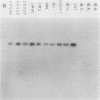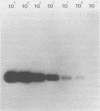Abstract
Current laboratory diagnosis of Lyme disease relies on tests for the detection of antibodies to Borrelia burgdorferi, the etiologic agent of the disease. These tests are often unreliable because of a lack of sensitivity and specificity and test-to-test variability. The purpose of this study was to evaluate the sensitivity and specificity of polymerase chain reaction (PCR) amplification for detection of B. burgdorferi in skin biopsy specimens. Forty-six 2-mm skin biopsy samples were obtained from 44 patients with a clinical diagnosis of erythema migrans, 9 of whom were receiving antibiotic therapy at the time of biopsy. Specimens were ground in BSK medium with separate aliquots taken for culture and PCR. Of the specimens from the untreated group, 57% (21 of 37) were positive by culture and 22% (8 of 37) were culture negative; 22% (8 of 37) of the cultures were uninformative because of contamination. By comparison, 22 (59%) of 37 specimens were positive by PCR amplification. Of 21 culture-positive samples, 13 (62%) were also positive by PCR analysis. Thus, the sensitivity of the PCR was 59 to 62%, based on either a clinical or cultural diagnosis of untreated Lyme disease. None of the nine specimens from antibiotic-treated patients grew in culture, whereas two of the nine were positive by PCR analysis. Given the complexity and time required for culture, PCR is a promising technique for the diagnosis of early Lyme disease.
Full text
PDF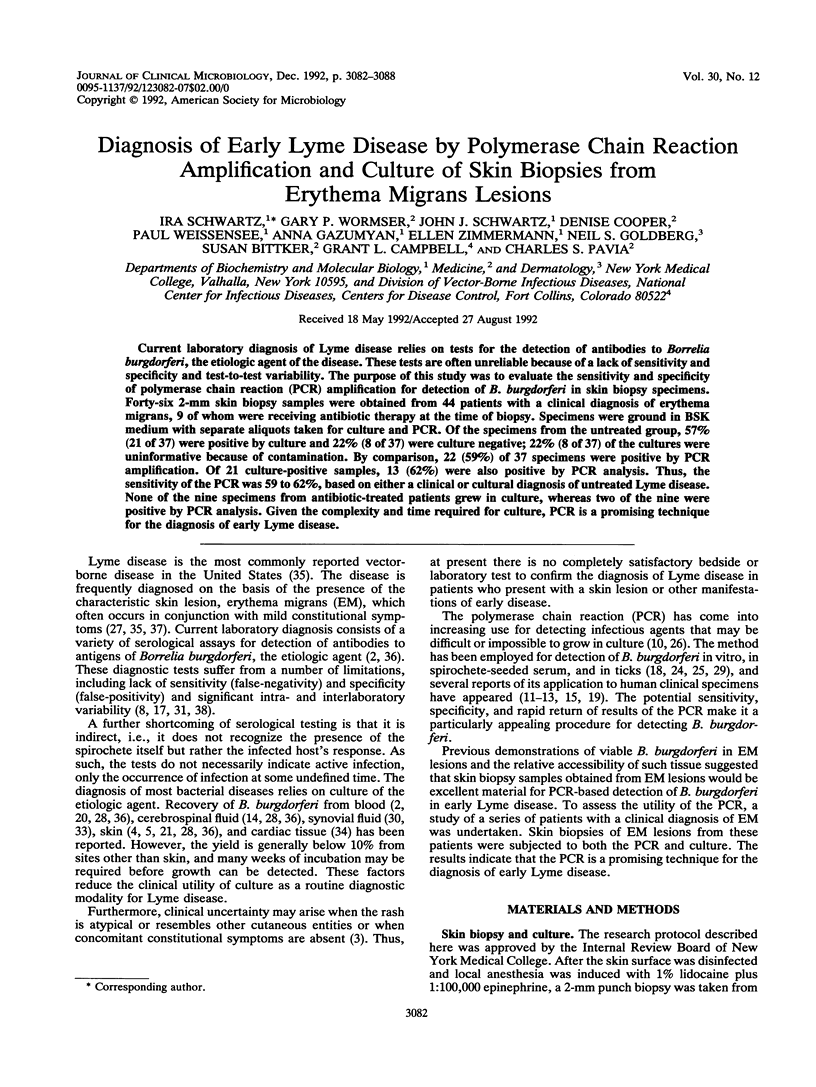
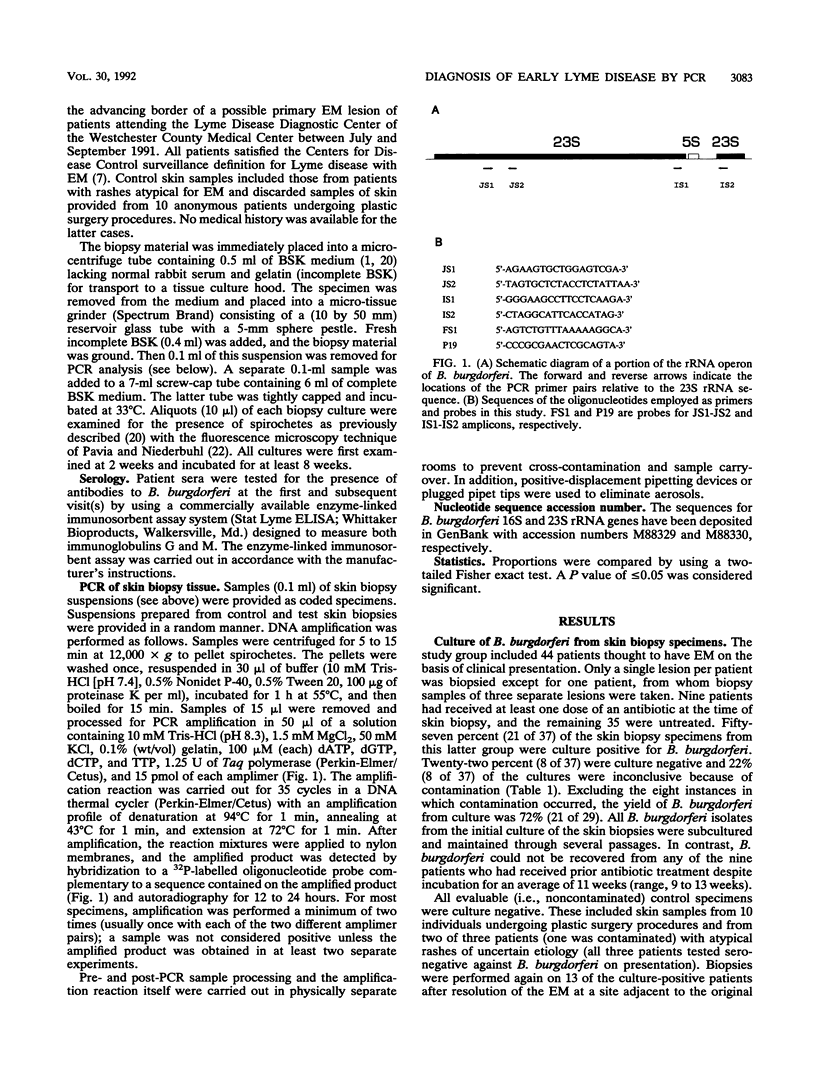


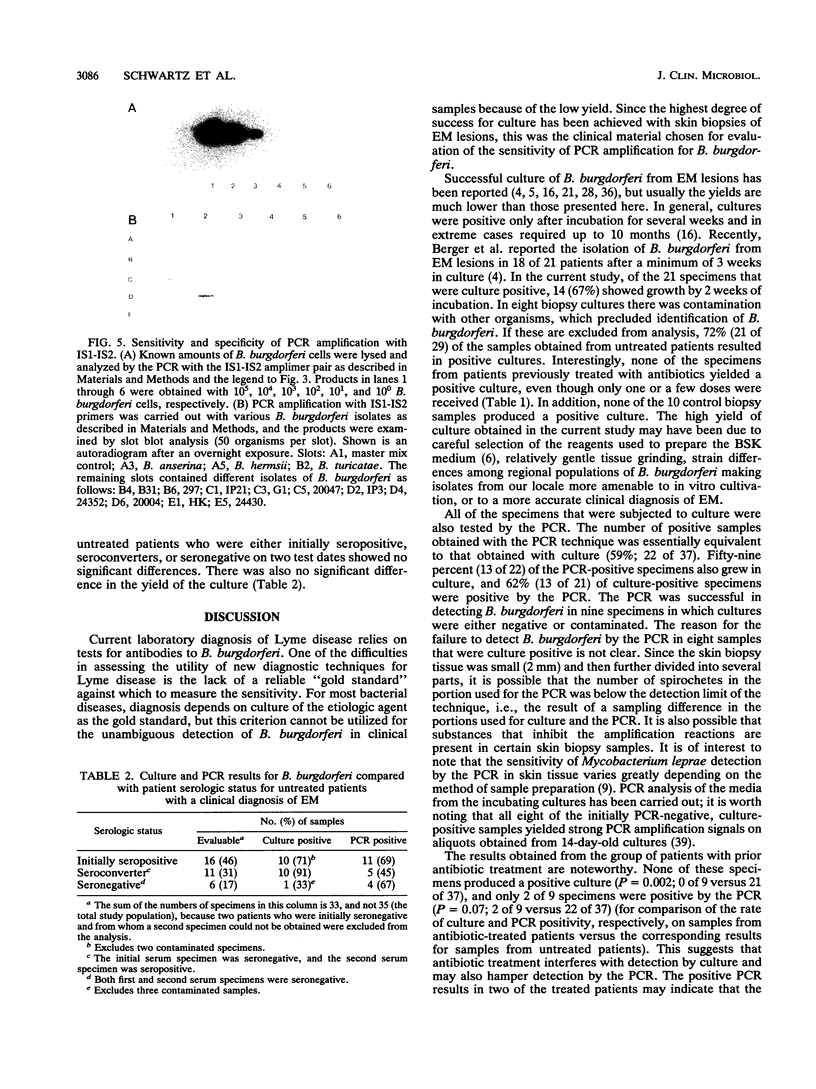
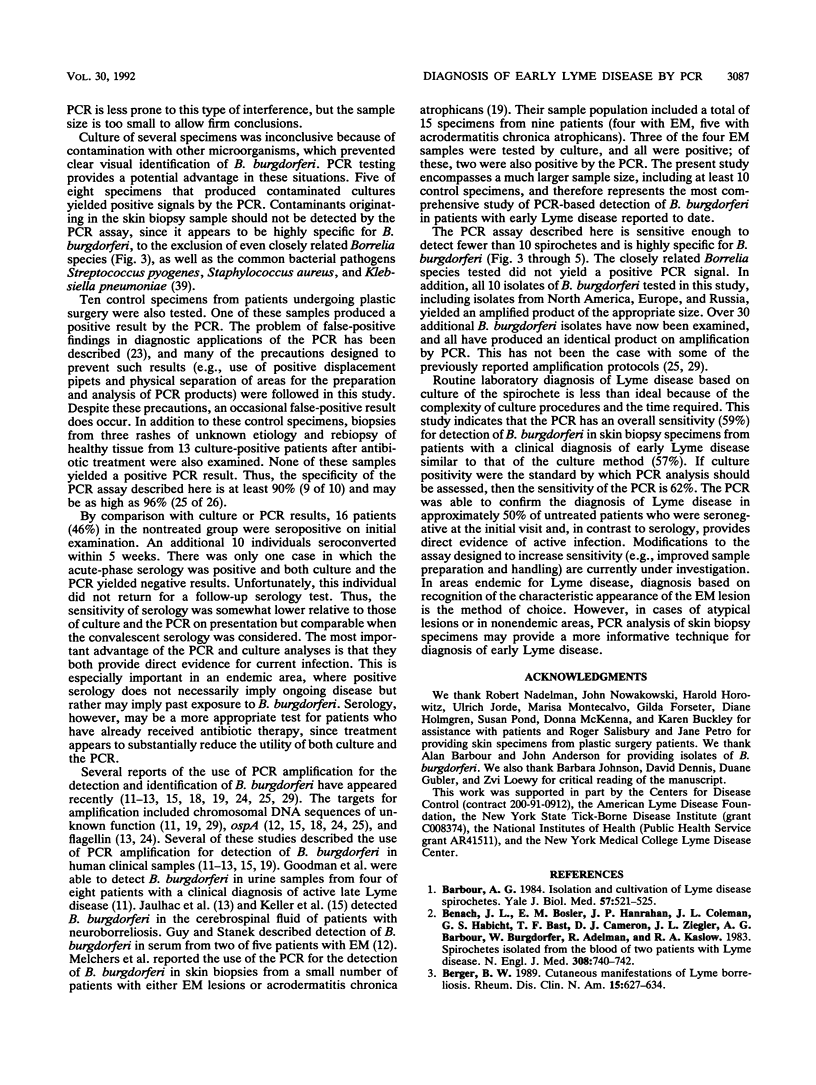
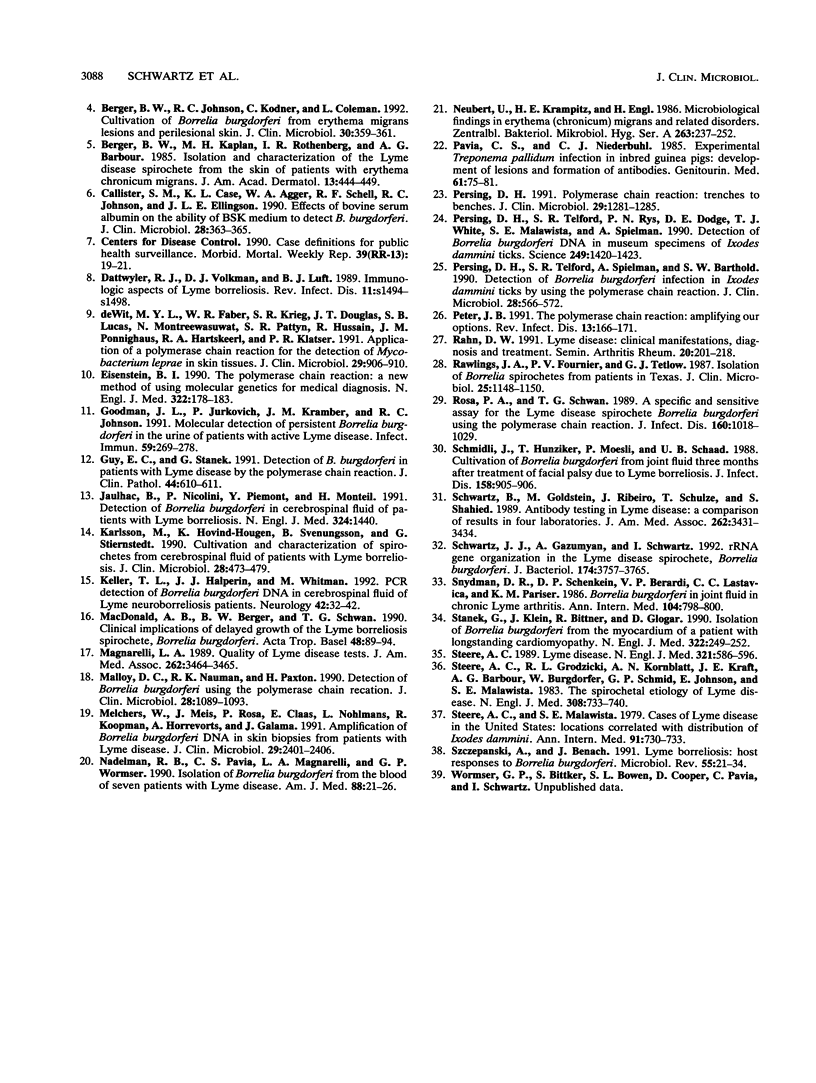
Images in this article
Selected References
These references are in PubMed. This may not be the complete list of references from this article.
- Barbour A. G. Isolation and cultivation of Lyme disease spirochetes. Yale J Biol Med. 1984 Jul-Aug;57(4):521–525. [PMC free article] [PubMed] [Google Scholar]
- Benach J. L., Bosler E. M., Hanrahan J. P., Coleman J. L., Habicht G. S., Bast T. F., Cameron D. J., Ziegler J. L., Barbour A. G., Burgdorfer W. Spirochetes isolated from the blood of two patients with Lyme disease. N Engl J Med. 1983 Mar 31;308(13):740–742. doi: 10.1056/NEJM198303313081302. [DOI] [PubMed] [Google Scholar]
- Berger B. W. Cutaneous manifestations of Lyme borreliosis. Rheum Dis Clin North Am. 1989 Nov;15(4):627–634. [PubMed] [Google Scholar]
- Berger B. W., Johnson R. C., Kodner C., Coleman L. Cultivation of Borrelia burgdorferi from erythema migrans lesions and perilesional skin. J Clin Microbiol. 1992 Feb;30(2):359–361. doi: 10.1128/jcm.30.2.359-361.1992. [DOI] [PMC free article] [PubMed] [Google Scholar]
- Berger B. W., Kaplan M. H., Rothenberg I. R., Barbour A. G. Isolation and characterization of the Lyme disease spirochete from the skin of patients with erythema chronicum migrans. J Am Acad Dermatol. 1985 Sep;13(3):444–449. doi: 10.1016/s0190-9622(85)70187-9. [DOI] [PubMed] [Google Scholar]
- Callister S. M., Case K. L., Agger W. A., Schell R. F., Johnson R. C., Ellingson J. L. Effects of bovine serum albumin on the ability of Barbour-Stoenner-Kelly medium to detect Borrelia burgdorferi. J Clin Microbiol. 1990 Feb;28(2):363–365. doi: 10.1128/jcm.28.2.363-365.1990. [DOI] [PMC free article] [PubMed] [Google Scholar]
- Dattwyler R. J., Volkman D. J., Luft B. J. Immunologic aspects of Lyme borreliosis. Rev Infect Dis. 1989 Sep-Oct;11 (Suppl 6):S1494–S1498. doi: 10.1093/clinids/11.supplement_6.s1494. [DOI] [PubMed] [Google Scholar]
- Eisenstein B. I. The polymerase chain reaction. A new method of using molecular genetics for medical diagnosis. N Engl J Med. 1990 Jan 18;322(3):178–183. doi: 10.1056/NEJM199001183220307. [DOI] [PubMed] [Google Scholar]
- Goodman J. L., Jurkovich P., Kramber J. M., Johnson R. C. Molecular detection of persistent Borrelia burgdorferi in the urine of patients with active Lyme disease. Infect Immun. 1991 Jan;59(1):269–278. doi: 10.1128/iai.59.1.269-278.1991. [DOI] [PMC free article] [PubMed] [Google Scholar]
- Guy E. C., Stanek G. Detection of Borrelia burgdorferi in patients with Lyme disease by the polymerase chain reaction. J Clin Pathol. 1991 Jul;44(7):610–611. doi: 10.1136/jcp.44.7.610. [DOI] [PMC free article] [PubMed] [Google Scholar]
- Jaulhac B., Nicolini P., Piemont Y., Monteil H. Detection of Borrelia burgdorferi in cerebrospinal fluid of patients with Lyme borreliosis. N Engl J Med. 1991 May 16;324(20):1440–1440. [PubMed] [Google Scholar]
- Karlsson M., Hovind-Hougen K., Svenungsson B., Stiernstedt G. Cultivation and characterization of spirochetes from cerebrospinal fluid of patients with Lyme borreliosis. J Clin Microbiol. 1990 Mar;28(3):473–479. doi: 10.1128/jcm.28.3.473-479.1990. [DOI] [PMC free article] [PubMed] [Google Scholar]
- Keller T. L., Halperin J. J., Whitman M. PCR detection of Borrelia burgdorferi DNA in cerebrospinal fluid of Lyme neuroborreliosis patients. Neurology. 1992 Jan;42(1):32–42. doi: 10.1212/wnl.42.1.32. [DOI] [PubMed] [Google Scholar]
- MacDonald A. B., Berger B. W., Schwan T. G. Clinical implications of delayed growth of the Lyme borreliosis spirochete, Borrelia burgdorferi. Acta Trop. 1990 Dec;48(2):89–94. doi: 10.1016/0001-706x(90)90047-4. [DOI] [PubMed] [Google Scholar]
- Magnarelli L. A. Quality of Lyme disease tests. JAMA. 1989 Dec 22;262(24):3464–3465. [PubMed] [Google Scholar]
- Malloy D. C., Nauman R. K., Paxton H. Detection of Borrelia burgdorferi using the polymerase chain reaction. J Clin Microbiol. 1990 Jun;28(6):1089–1093. doi: 10.1128/jcm.28.6.1089-1093.1990. [DOI] [PMC free article] [PubMed] [Google Scholar]
- Melchers W., Meis J., Rosa P., Claas E., Nohlmans L., Koopman R., Horrevorts A., Galama J. Amplification of Borrelia burgdorferi DNA in skin biopsies from patients with Lyme disease. J Clin Microbiol. 1991 Nov;29(11):2401–2406. doi: 10.1128/jcm.29.11.2401-2406.1991. [DOI] [PMC free article] [PubMed] [Google Scholar]
- Nadelman R. B., Pavia C. S., Magnarelli L. A., Wormser G. P. Isolation of Borrelia burgdorferi from the blood of seven patients with Lyme disease. Am J Med. 1990 Jan;88(1):21–26. doi: 10.1016/0002-9343(90)90122-t. [DOI] [PubMed] [Google Scholar]
- Neubert U., Krampitz H. E., Engl H. Microbiological findings in erythema (chronicum) migrans and related disorders. Zentralbl Bakteriol Mikrobiol Hyg A. 1986 Dec;263(1-2):237–252. doi: 10.1016/s0176-6724(86)80127-4. [DOI] [PubMed] [Google Scholar]
- Pavia C. S., Niederbuhl C. J. Experimental infection of inbred guinea pigs with Treponema pallidum: development of lesions and formation of antibodies. Genitourin Med. 1985 Apr;61(2):75–81. doi: 10.1136/sti.61.2.75. [DOI] [PMC free article] [PubMed] [Google Scholar]
- Persing D. H. Polymerase chain reaction: trenches to benches. J Clin Microbiol. 1991 Jul;29(7):1281–1285. doi: 10.1128/jcm.29.7.1281-1285.1991. [DOI] [PMC free article] [PubMed] [Google Scholar]
- Persing D. H., Telford S. R., 3rd, Rys P. N., Dodge D. E., White T. J., Malawista S. E., Spielman A. Detection of Borrelia burgdorferi DNA in museum specimens of Ixodes dammini ticks. Science. 1990 Sep 21;249(4975):1420–1423. doi: 10.1126/science.2402635. [DOI] [PubMed] [Google Scholar]
- Persing D. H., Telford S. R., 3rd, Spielman A., Barthold S. W. Detection of Borrelia burgdorferi infection in Ixodes dammini ticks with the polymerase chain reaction. J Clin Microbiol. 1990 Mar;28(3):566–572. doi: 10.1128/jcm.28.3.566-572.1990. [DOI] [PMC free article] [PubMed] [Google Scholar]
- Peter J. B. The polymerase chain reaction: amplifying our options. Rev Infect Dis. 1991 Jan-Feb;13(1):166–171. doi: 10.1093/clinids/12.5.166. [DOI] [PubMed] [Google Scholar]
- Rahn D. W. Lyme disease: clinical manifestations, diagnosis, and treatment. Semin Arthritis Rheum. 1991 Feb;20(4):201–218. doi: 10.1016/0049-0172(91)90017-t. [DOI] [PubMed] [Google Scholar]
- Rawlings J. A., Fournier P. V., Teltow G. J. Isolation of Borrelia spirochetes from patients in Texas. J Clin Microbiol. 1987 Jul;25(7):1148–1150. doi: 10.1128/jcm.25.7.1148-1150.1987. [DOI] [PMC free article] [PubMed] [Google Scholar]
- Rosa P. A., Schwan T. G. A specific and sensitive assay for the Lyme disease spirochete Borrelia burgdorferi using the polymerase chain reaction. J Infect Dis. 1989 Dec;160(6):1018–1029. doi: 10.1093/infdis/160.6.1018. [DOI] [PubMed] [Google Scholar]
- Schmidli J., Hunziker T., Moesli P., Schaad U. B. Cultivation of Borrelia burgdorferi from joint fluid three months after treatment of facial palsy due to Lyme borreliosis. J Infect Dis. 1988 Oct;158(4):905–906. doi: 10.1093/infdis/158.4.905. [DOI] [PubMed] [Google Scholar]
- Schwartz B. S., Goldstein M. D., Ribeiro J. M., Schulze T. L., Shahied S. I. Antibody testing in Lyme disease. A comparison of results in four laboratories. JAMA. 1989 Dec 22;262(24):3431–3434. [PubMed] [Google Scholar]
- Schwartz J. J., Gazumyan A., Schwartz I. rRNA gene organization in the Lyme disease spirochete, Borrelia burgdorferi. J Bacteriol. 1992 Jun;174(11):3757–3765. doi: 10.1128/jb.174.11.3757-3765.1992. [DOI] [PMC free article] [PubMed] [Google Scholar]
- Snydman D. R., Schenkein D. P., Berardi V. P., Lastavica C. C., Pariser K. M. Borrelia burgdorferi in joint fluid in chronic Lyme arthritis. Ann Intern Med. 1986 Jun;104(6):798–800. doi: 10.7326/0003-4819-104-6-798. [DOI] [PubMed] [Google Scholar]
- Stanek G., Klein J., Bittner R., Glogar D. Isolation of Borrelia burgdorferi from the myocardium of a patient with longstanding cardiomyopathy. N Engl J Med. 1990 Jan 25;322(4):249–252. doi: 10.1056/NEJM199001253220407. [DOI] [PubMed] [Google Scholar]
- Steere A. C., Grodzicki R. L., Kornblatt A. N., Craft J. E., Barbour A. G., Burgdorfer W., Schmid G. P., Johnson E., Malawista S. E. The spirochetal etiology of Lyme disease. N Engl J Med. 1983 Mar 31;308(13):733–740. doi: 10.1056/NEJM198303313081301. [DOI] [PubMed] [Google Scholar]
- Steere A. C. Lyme disease. N Engl J Med. 1989 Aug 31;321(9):586–596. doi: 10.1056/NEJM198908313210906. [DOI] [PubMed] [Google Scholar]
- Steere A. C., Malawista S. E. Cases of Lyme disease in the United States: locations correlated with distribution of Ixodes dammini. Ann Intern Med. 1979 Nov;91(5):730–733. doi: 10.7326/0003-4819-91-5-730. [DOI] [PubMed] [Google Scholar]
- Szczepanski A., Benach J. L. Lyme borreliosis: host responses to Borrelia burgdorferi. Microbiol Rev. 1991 Mar;55(1):21–34. doi: 10.1128/mr.55.1.21-34.1991. [DOI] [PMC free article] [PubMed] [Google Scholar]
- de Wit M. Y., Faber W. R., Krieg S. R., Douglas J. T., Lucas S. B., Montreewasuwat N., Pattyn S. R., Hussain R., Ponnighaus J. M., Hartskeerl R. A. Application of a polymerase chain reaction for the detection of Mycobacterium leprae in skin tissues. J Clin Microbiol. 1991 May;29(5):906–910. doi: 10.1128/jcm.29.5.906-910.1991. [DOI] [PMC free article] [PubMed] [Google Scholar]



